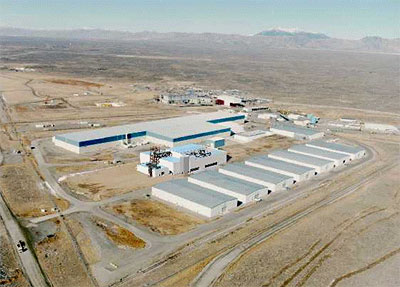I have written about problems at the Idaho National Laboratory before. The INL is a federal nuclear research facility established in 1949 to research nuclear reactors. More than fifty experimental reactors have been constructed at the site. In 1995, an agreement was reached between the Department of Energy (DoE) and the State of Idaho for cleanup of nuclear wastes at INL. The Advanced Mixed Waste Treatment Facility (AMWT) was constructed around 2003 for the "characterization, treatment, packaging, shipment and disposal of an estimated sixty six thousand cubic yards of waste stored at the Idaho facility. The waste includes DOE laboratory and processing materials from the former Rocky Flats nuclear weapons plant in Colorado and various other DOE facilities in Idaho and across the country." The reprocessed waste is shipped to permanent waste disposal facilities in New Mexico, Nevada and Utah. All of the existing waste is supposed to be disposed of by 2018 under the agreement with the State of Idaho.
In 2005, the research and nuclear waste cleanup were split. Battelle took over management of INL research from Bechtel. CH2M-WG Idaho took over cleanup from Bechtel under the Idaho Cleanup Project. In 2011, the U.S. Department of Energy transferred the cleanup contract at INL from CH2M-WG Idaho to a consortium of nuclear companies called the Idaho Treatment Group to carry out waste processing at the INL site. This summer, the contract for waste processing at AWMTF will be transferred to a company named Fluor.
The AMWTF currently employs around seven hundred people. It is undergoing a remodeling and upgrade worth about ten million dollars. This upgrade was necessary because some of the equipment was deteriorating to the point where more and more money had to be spent just to keep it operating. The DoE hopes that the modifications will help the AMWTF complete the cleanup of nuclear waste by the mandated 2018 deadline. The value of the AMWTF and infrastructure is estimated at about one billion dollars.
The waste is "held in slowly deteriorating metal, wooden and fiberglass boxes and metal drums, the waste includes tools, rags, clothing, sludge and dirt - anything contaminated with a transuranic element, such as plutonium, during the weapon-making process." Over fifty thousand cubic yards of waste have been processed which leaves around twelve thousand cubic yards to go.
There are some serious problems that may prevent the DoE from meeting 2018 deadline. A great deal of the reprocessed waste was supposed to be shipped to the Waste Isolation Pilot Plant disposal site in New Mexico. Unfortunately, there was an accident there last year and the facility is closed for repairs. Meanwhile, twenty thousand containers of waste have piled up at the AWMTF awaiting shipment to New Mexico.
After the treatment of the existing waste has been completed, there are discussions about shipping other waste to the facility from DoE sites around the U.S. for reprocessing and final shipment to permanent disposal sites. There is no other DoE facility that has the capabilities of the AMWTF. The new waste would come from places such as the Hanford Nuclear Reservation in Washington State and the Los Alamos National Laboratory in New Mexico. Between them, these two sites have over twenty five thousand cubic yards of nuclear waste. The agreement between DoE and Idaho does allow waste from other states to be shipped in and processed as long as it is shipped back out within a year. However, there is public opposition in Idaho for treating additional waste at the AMWTF.
Advanced Mixed Waste Treatment Facility:
